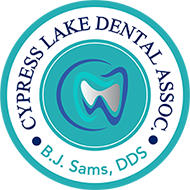RETURNING TEETH TO HEALTH AND STRENGTH
Time can certainly take a toll on your teeth, no matter how well you take care of them. For most of us, teeth can eventually wear down, crack, break, and decay. Regardless of the condition your teeth may be in, you owe it to your smile and dental health to restore them. With the many restorative dental treatments offered at Cypress Lake Dental there’s no reason to live with damaged, unattractive or unhealthy teeth.
From natural-looking porcelain restorations that replace metal fillings, to dental implants that permanently replace missing teeth, any smile can be returned to optimal health, appearance, comfort and function. However, not every patient is in a position to afford ideal dentistry, and whenever possible alternate treatment plans will be offered, including spreading the treatment over longer periods of time
Restoration Dentistry Procedures
Crowns
 Dental restorations restore the function, integrity, and morphology of missing tooth structure, which can be caused by caries or external trauma, such as chipping or cracking a tooth. Fabrication of a crown (a type of dental restoration) usually requires two dental visits. The first visit involves an examination of the tooth to determine how it should be restored and preparation of the tooth for the restoration; this visit may include a core build-up (sometimes requiring a post), fabrication of a temporary crown, and making an impression to be sent to the laboratory. The second visit usually involves delivery of the final restoration, which has been fabricated in the laboratory.
Dental restorations restore the function, integrity, and morphology of missing tooth structure, which can be caused by caries or external trauma, such as chipping or cracking a tooth. Fabrication of a crown (a type of dental restoration) usually requires two dental visits. The first visit involves an examination of the tooth to determine how it should be restored and preparation of the tooth for the restoration; this visit may include a core build-up (sometimes requiring a post), fabrication of a temporary crown, and making an impression to be sent to the laboratory. The second visit usually involves delivery of the final restoration, which has been fabricated in the laboratory.
Permanent Bridges
An empty space, or gap, in your smile may affect your chewing and speaking abilities—and your self-confidence. If you’re missing one or more teeth, your dentist may recommend a fixed bridge as a treatment option.

Partial and Full Dentures
Missing teeth can affect the way you eat and speak, and they can impact your appearance and self-esteem. Dentures are custom-made removable appliances, provided by a dentist, that can help alleviate these problems by replacing missing teeth. Dentures are made of acrylic resin, sometimes in combination with various metals. Learn more about the process of receiving dentures and which types of dentures are available to you.

Root Canal Therapy
Inside your teeth is a soft material called pulp that contains blood vessels, nerves, and connective tissue. If this pulp becomes infected, it can cause severe tooth pain. In some cases, that infection will require root canal therapy.


